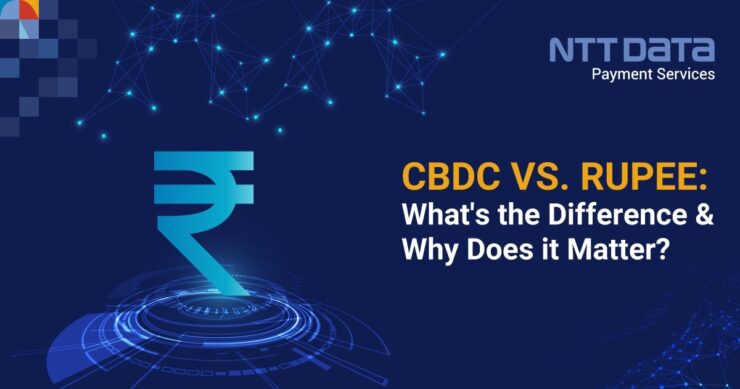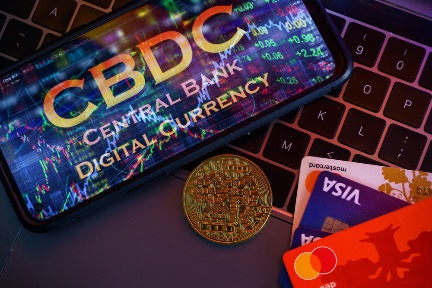
Table of Contents
- 1 CBDC vs Rupee: How Are They Different?
- 2 The Main Benefits Of CBDCs
- 3 How Are CBDCs Different From Cryptocurrency?
- 4 Why Do CBDCs Matter And What Is Their Effect On The Indian Economy?
- 5 Accept Payments Anytime With Multiple Payment Options At NTT DATA Payment Services
- 6 Conclusion
- 7 CBDC vs Rupee: Frequently Asked Questions (FAQs)
The financial world is not immune to this trend as we rush towards an increasingly digital future. One of the most significant developments in recent years has been the advent of Central Bank Digital Currencies (CBDCs), including India’s proposed digital rupee.
While many people are excited about the potential for CBDCs to revolutionise how we transact and store value, others remain uncertain about their implications for financial stability and privacy.
In this blog post, we will explore the differences between CBDC vs Rupee – traditional currencies and discuss why the emergence of CBDCs is such a significant development for the future of money. Keep reading the blog to know more about these digitized currencies, which we call the e-₹!
CBDC vs Rupee: How Are They Different?
The Central Bank Digital Currency (CBDC) and the Indian Rupee are two different types of money. The Indian Rupee is a fiat currency issued by the Reserve Bank of India (RBI), whereas CBDCs are digital counterparts of fiat currencies issued by the central bank as well.
Here is a comparison table highlighting some key differences between CBDCs and the Indian rupee:
|
CBDC (e-₹) |
Indian Rupee |
|
| Definition | A digital currency that a central bank issues and administers. | The RBI issues and controls the national currency of India. |
| Form | Only exists in digital form. | Exists in both physical (banknotes and coins) and digital form (UPI). |
| Regulation | Issued and regulated by the central bank. | Also regulated by the Reserve Bank of India. |
| Legal Tender | Since CBDCs are legal tender, they can be used to pay taxes and bills. | The Indian rupee is legal tender in India, Nepal and Bhutan. |
| Technology | For security and transparency, CBDCs use blockchain or distributed ledger technology. | The Indian rupee uses traditional banking systems and infrastructure. |
| Privacy | Transactions with CBDC can be tracked, which may cause privacy issues. | Cash transactions using the Indian rupee are generally more private than digital transactions. |
As CBDCs develop, it will be interesting to watch how they will complement or perhaps even replace existing forms of currency, such as the Indian rupee.
The Main Benefits Of CBDCs

There are a lot of potential advantages that CBDCs have to offer over traditional fiat currencies. Here are some of them:
- CBDCs can make transactions faster and more efficient, lowering transaction costs and increasing transaction speeds.
- CBDCs can promote financial inclusion by allowing people to conduct digital transactions without having to apply for a bank account, particularly in areas where traditional banking services are scarce.
- They are more secure and less susceptible to counterfeiting than actual banknotes and coins as they are issued and administered by central banks.
- They may grant central banks more control over the money supply, allowing them to pursue more effective monetary policies.
- CBDCs can improve financial transaction transparency by keeping a clear record of all transactions, making it easier to trace and combat financial crime.
How Are CBDCs Different From Cryptocurrency?
Central Bank Digital Currencies (CBDCs) and cryptocurrencies share similarities as they are both digital currencies. However, there are also significant differences between the two.
Here’s a more clear representation of their differences:
|
CBDCs |
Cryptocurrency |
|
| Regulatory framework | Issued and regulated by central banks and are therefore legal tender backed by the government | Decentralized and do not have any central authority or government backing |
| Intended use | Designed to work within existing financial systems and are meant to complement fiat currencies | Aims to challenge traditional financial systems and often seeks to replace fiat currencies |
| Underlying technology | CBDCs are centralized, i.e., they are controlled by a central authority | Cryptocurrencies are decentralized and rely on blockchain technology and consensus mechanisms |
Why Do CBDCs Matter And What Is Their Effect On The Indian Economy?
Central Bank Digital Currencies (CBDCs) are of significance as they have the potential to change the way we use money. CBDCs provide several benefits over traditional fiat currencies, including increased efficiency, financial inclusion, lower counterfeit risk, better monetary policy, and increased transparency.
The Indian economy could be significantly impacted by CBDCs. How?
CBDCs can offer increased financial inclusion and access to financial services as a nation with a sizable unbanked population and a developing digital economy. CBDCs can also lower the cost and hassle of traditional banking services by enabling digital transactions without the requirement for a bank account.
Additionally, they could also reduce the need for physical coins and banknotes, which would cut down on the price of producing and distributing physical money.
But the introduction of CBDCs in India also prompts worries about surveillance, privacy, and possible centralization. To guarantee that CBDCs can offer a safe and fair financial system for everyone, it will be crucial to strike a balance between these potential benefits and hazards.
Accept Payments Anytime With Multiple Payment Options At NTT DATA Payment Services
As India continues to explore the potential of CBDCs, questions arise about how they will impact the traditional rupee. Though CBDCs are considered to be more beneficial and instant than physical cash, ultimately, both CBDCs and the rupee could coexist and complement each other in India’s economic setting.
NTT DATA Payment Services offers a complete payment solution to advance both your offline and online businesses from,
- Online Payment Gateway
- POS machines
- IVR payments
- Mobile applications, and
- Bharat QR Scan and Pay
We ensure maximum comfort, convenience, and safety for all your payments.
Conclusion
As the world continues to move towards a cashless society, CBDCs have the potential to revolutionize the way we conduct transactions, making them more efficient and secure.
The difference between CBDC and the rupee is simple: the former is the digital version of the latter. That’s it!
But while CBDCs are a form of electronic money, they also differ from cryptocurrencies and other digital currencies as a central bank backs them and is legal tender.
In India, the Reserve Bank of India (RBI) is exploring the possibility of introducing a digital version of the Indian rupee, which could offer several benefits, such as reduced costs and increased financial inclusion. However, there are also concerns about privacy and surveillance.
As the development of CBDCs continues, it will be crucial to balance these potential benefits and concerns to ensure a secure and equitable financial system for all.
| Also, you can get frequent updates on nttdatapayments Instagram |
CBDC vs Rupee: Frequently Asked Questions (FAQs)
1. What is the difference between CBDC and electronic money?
CBDCs are digitized versions of fiat currencies produced and backed by RBI, whereas electronic money refers to any type of digital currency including cryptocurrencies. As a result, CBDCs are a subset of electronic money.
2. Can CBDCs replace UPI?
No, CBDCs are not predicted to replace the country’s fastest-growing and instant payment system- UPI. However, CBDCs are expected to replace physical cash after they have been fully implemented and integrated nationwide.
3. Are CBDCs the same as a digital wallet?
CBDCs and digital wallets are not the same thing. A digital wallet is a software application that saves digital assets such as payment cards or cryptocurrencies. CBDCs are a type of digital currency that can be saved in a digital wallet.


